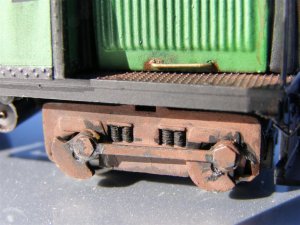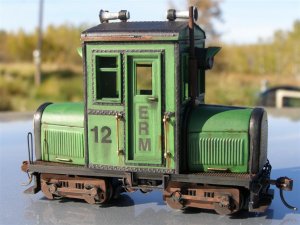This was weathered using plain artist pastels. The model isn't coated with anything over top of the pastel. The solid rust on the roof, trucks, exhaust and couplers is pastel mixed with hairspray and painted on the model. In other places it is used dry. I rub it in really good with a Q-tip and brush away the excess. I then rub it in even better with my finger(I wear rubber gloves for this part). Once it is rubbed in good, it doesn't come off easily, but with a lot of handling, after time it will fade out. This technique is used for the black on the model. It ends up looking like the black around the door handle on the cab. I just give it a little more to touch it up if needed. I usually don't weather it, where I pick the model up, so this usually isn't a problem for me. For really heavily weathered cars I usually will give the car a thinned out coat of Dullcote to seal it. I have a few different types of weathering powders as well, but I hardly ever use them, except to tint the color of the pastels. The powders stick with a bit less effort, but for the popular powders, I have a hard time justifying the price when cheap pastels work fine for me. The main thing in applying pastels is to have a flat, not shiny surface, to put your powders on. Nothing will stick well to a shiny surface. If you are painting the model, a couple coats of acrylic paint is all that is needed. If you are weathering a factory painted model give it a light coat of dullcoat or similar product before you start weathering. If you are going to be handling the cars a lot, I recommend a coat of clear over the top as others have mentioned, but if you are even a little careful, it shouldn't come off. I don't coat most of my models, because I like the look better without the clear. Dust looks dustier and rust seems to look rustier. Hope this this makes at least some sense and helps you out a bit. Ron






